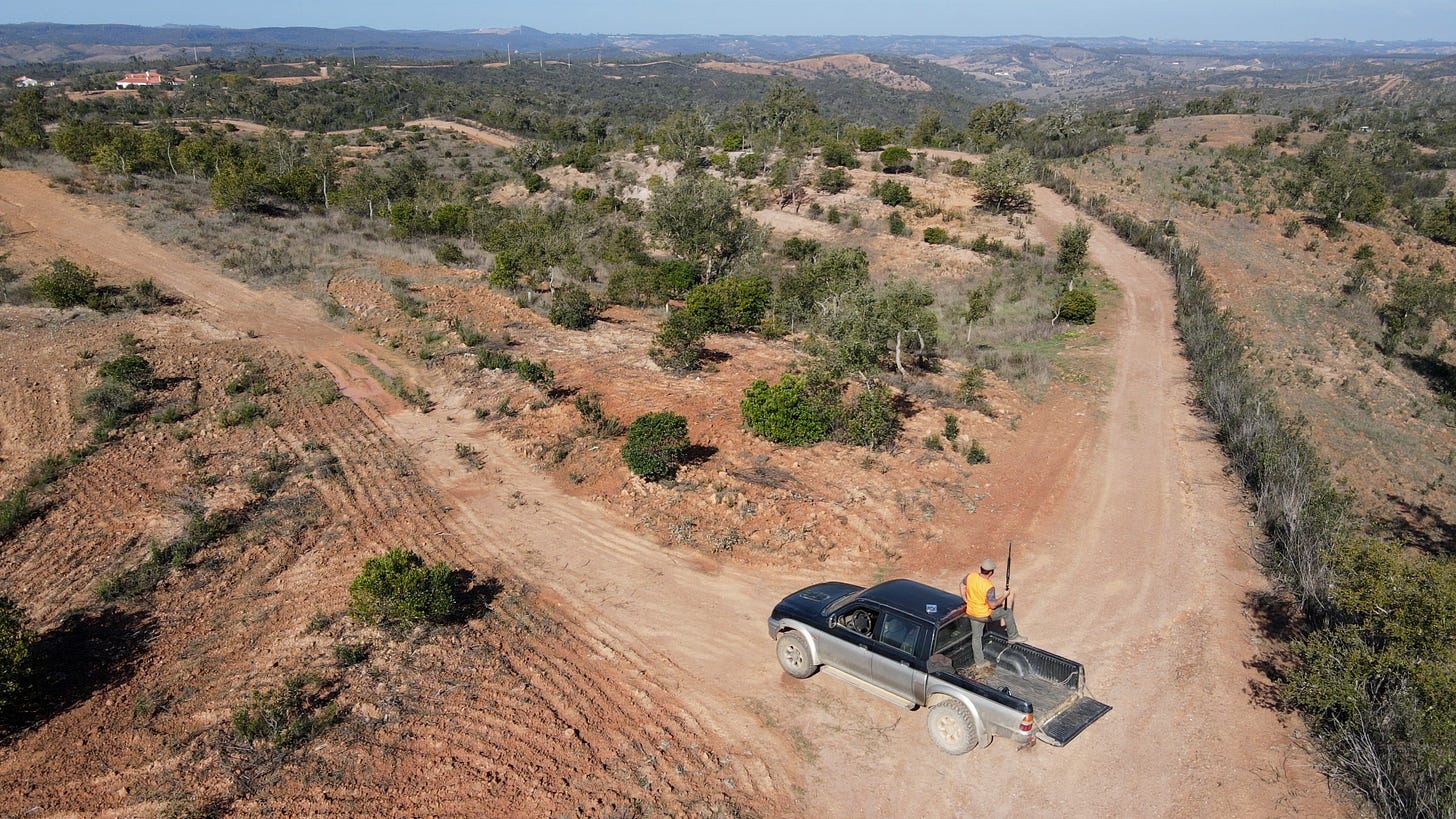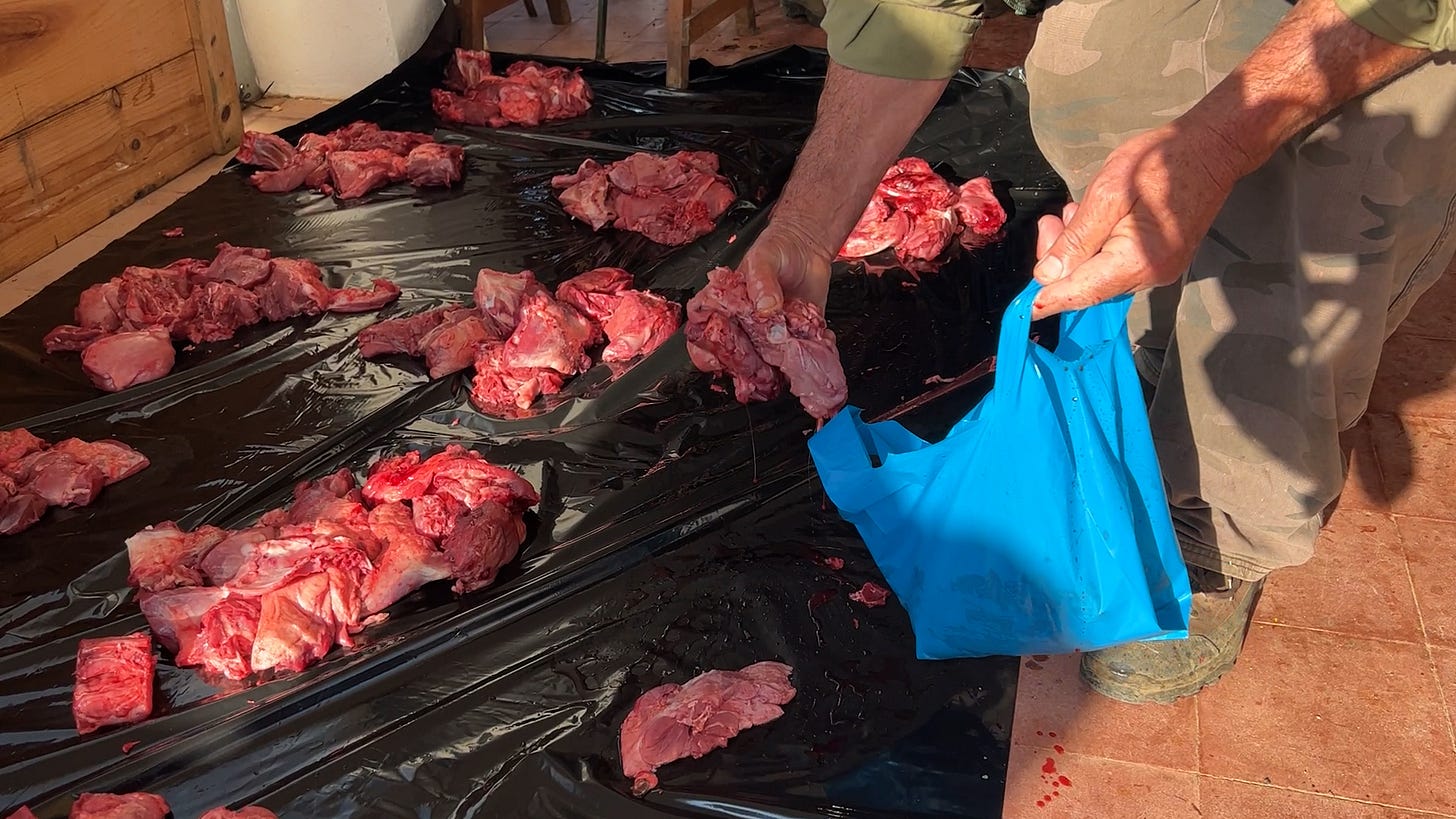The invitation came after dark with a big smile and two small blue plastic bags of meat.
The local hunting association had been in our area and the portions of deer and wild boar (wild boar) in the bags were a share of the day’s proceeds.
And now the Cow King was at our door with gifts and a invitation to join them the following week on the last montaria hunt of the season – an ancient form of hunting unique to the Iberian peninsula.
While working as the BBC’s Africa Correspondent I covered a lot of stories on wildlife and reported on the fierce debate over hunting.
Opinions vary on a sliding scale from all meat is murder to big game hunting rare rhinos is OK...but it’s subjective and it’s complicated.
While very much respecting the view of vegans, I do eat some meat (not that much, even before my health check!) and therefore need to be OK with animals being killed so I can eat them.
I don’t like the factory-farming meat industry, but here in Odemira the animals are well treated – the Cow King’s herds are free ranging and beautifully kept and as Medronho Jorge says, his pigs have “364 amazing days and then one really bad one.”
So...Cows? Sure. Pigs? Absolutely.
Deer? I do eat venison. Springboks? Yes. Zebras? Not threatened or protected and used for meat – OK. Buffalo? Hmm. Elephants? I certainly wouldn’t. Endangered rhinos? Absolutely not...but listen to this great radio documentary later and it might challenge your views.
But wild boar? Yep – I’m OK with that. Of course it’s not just what you hunt but how you hunt it and hunting with dogs can be controversial.
The javali population in Portugal – and across Europe for that matter – is exploding.
They destroy land and crops and can attack livestock, pets and people.
We were told boars have two or three babies, but when they cross-breed with the porco preto black pigs they can have six or seven...throw in the hunting restrictions during the pandemic and you have an even bigger problem.
When we first moved in they used to party in our lake and wear out our pine tree trunks by scratching...but the arrival of our horse/dog and night guard Garfunkel closed down the raves.
“You got trotters? You’re not coming in.”
Their only natural predator here is the associação de caça – the hunting club – headquartered in a former primary school building tucked under the distant windmill hill we can see from our house.
We met at the main road at 7.30am sharp and followed Cow King Antonio Oliveira and his son to the club HQ.
The pick-up trucks were arriving and camouflage and khaki-clad Alentejo men were assembling, as a production line of eggy bread and sausages was being distributed with coffee and the occasional beer.
We were warmly welcomed by club president Sr Garcia and a great mixture of people aged from early 20s to one guy in his 80s, and there were also a few familiar faces including Paulo the insurance man and José our building engineer.
The Cow King had suggested I bring a video camera and so along with a basic filming rig and a drone I had a job for the day: producing a little film for our new friends.
I understand Portuguese well now, but I’m still afraid of talking (!) and although Ana said this was a guy thing, she was invited and was pleasantly surprised to hear the old guard saying they would welcome more women in the club.
Life in rural Alentejo is still quite hierarchical and women’s equality still has a long way to go.
Once everyone’s tanks were full the lottery began.
The montaria hunting style here dates back to the 14th century and involves circling a wide area of land with hunters positioned a set distance apart and then leading a pack of dogs into the middle to drive the animals out.
The lottery was to decide who would have which positions and once all the numbers had been pulled from a bag, a convoy of bakkies hit the road and the hunters took up their spots to sit and wait wearing high-vis vests to prevent any accidents.
We were given the high ground and a panoramic view of the cork oak and overgrown bush and scrub landscape as the dogs were released with a shouting and whistling of directions.
It wasn’t long before short flurries of distant shots started echoing around the valley.
The association has access to various large swathes of local land because of historic permissions – you have to opt out rather than in – and they hunt each area once or twice a season.
The hunter nearest to us was watching a wild boar track on the other side of a low fence, but it was a quiet spot – even when the dogs were near there was nothing.
Suddenly I heard a rustle and a startled young female deer emerged from the bushes.
The hunter reached for his gun and then shook his head: “too young” he said as it ran along the fence down the hillside.
“Eu sou caçador, não matador,” he told us afterwards (“I’m a hunter, not a killer.”)
Another hunter had a pot shot which hit the dirt road and kicked up a cloud of dust, but the deer had broken the line and she was gone. And that was our closest encounter.
We had been out nearly four hours when the exhausted dogs returned to their mobile kennel and we headed back to the old school.
After a flurry of dust and trucks six large wild boar lay prostrate on the floor as the hunters grabbed a bite, a beer and then got to work on an efficient production line of butchery stations.
Two weeks earlier they had shot 24 javali we were told – in the area near our land – but this was a reasonable haul on the last day of the season given they had done just one hunt rather than the usual two.
A small group of men bundled a boar onto each coarsely made wooden table, and working together sliced their carcass open, removed the skin, the organs, washed out the blood and cut it into big sections.
These were delivered to a large table where three butchers quickly cleaved and sliced the meat into different buckets by quality of cut – it went from “boar” to “meat” at astonishing speed and efficiency.
Black plastic sheets were laid out as another team began carefully and fairly separating the meat into piles of equal quantity and quality to be collected in little blue bags once the work was done.
As the names were called and the bags were stashed, a barbecue for 40 began...but sadly we had to slink off home to study wine (rather than drink it with piles of BBQ chicken) ahead of Ana’s WSET exam.
I’ve run out of space to delve deeply into the pros and cons of big game hunting, but two big pros are controlling numbers and raising big money for the parks and the rangers who protect the animals and the ecosystems.
In Namibia I learned how wildlife surveys to set hunting quotas provide work for trackers who would otherwise be employed by poachers, but regulation is key and in many African parks corruption is rife.
There are moral debates and passionately held opinions on both sides.
(If you have time this is a fun long-read I did for the BBC website and this is the TV documentary we did for the News Channel – and this piece on Cecil the Lion from 2015 is surprising).
Elephants might be great to see on safari, but you wouldn’t them as neighbours: they destroy land and crops and can attack livestock, pets and people.
And where have we heard that phrase before?















